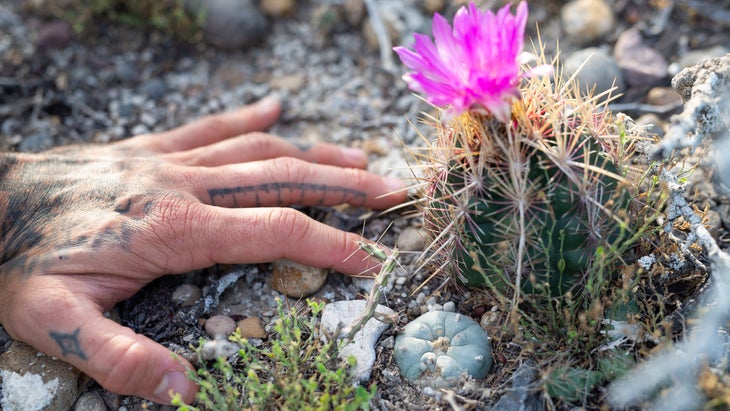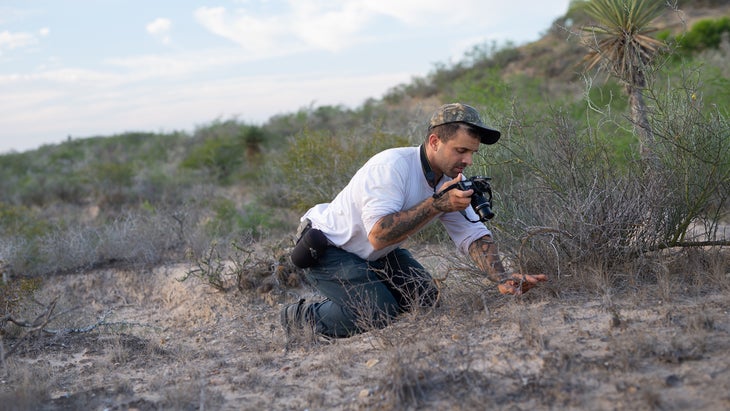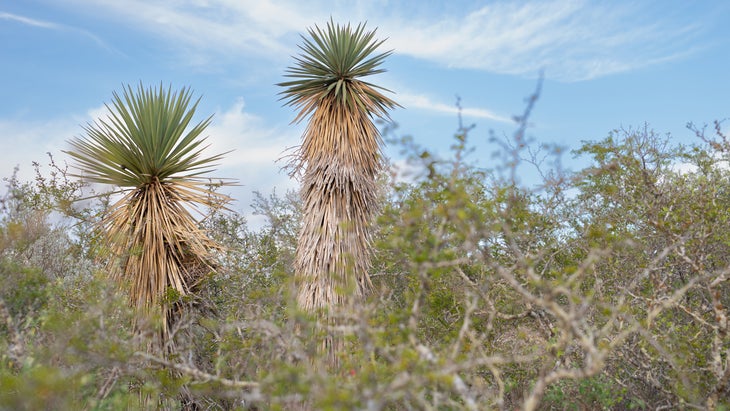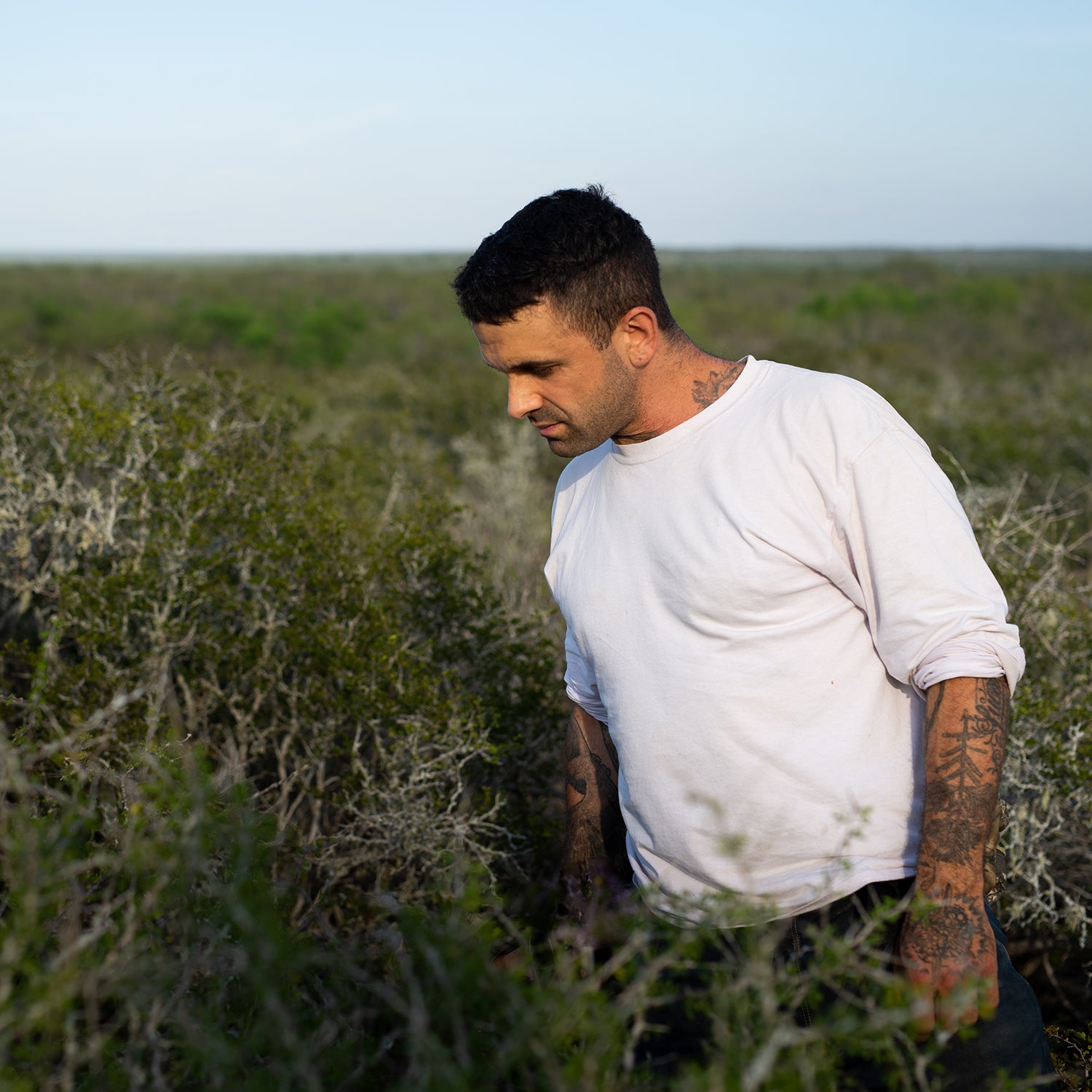On the squat scrublands of a ranch property in Starr County, Texas, a few miles from the Mexico border, the ground is specked with a constellation of gray-green, quarter-size buttons of the cactus Lophophora williamsii—peyote—which contain the oldest psychedelic medicine known to man. A mystic light washes through the scene and the air is hushed, until a voice in a thick Chicago accent breaks the silence.
“Lookadat! Pey-ote. Whole shit tons of pey-ote, just doing their thing… blending in with the��gravels that have been deposited here over the da tree-hundred-thousand years by da meandering channel of the Rio Grand-ee.”
Joey Santore holds his cell phone, widescreen-style, in his fingers, one of which is tattooed with a ruler’s hash marks. He’s squatting in carpenter jeans and dusty black oxfords, scanning each of the rare cactus species while capturing a video of the plants in close focus.
“And here you’ve got �Ұ��ܲ��DzԾ���,��dog cholla, called that because it gets stuck in a dog’s paws…. You’ve got your ��ǰ����Գٳ�,��beehive cactus… all of this, growing in the dappled light and calcareous soil of the Tamaulipan thorn-scrub understory. Which, of course, is getting cleared away at an increasing rate to make room for the fucking Panda Express and the wind farms and the general tumor of modern society. Kind of a bummer!”
Welcome to a fairly standard Saturday in the world of , a YouTube channel where Santore, a 39-year-old ex-punk and former freight train engineer who is self-taught in his field, films the trips he takes in search of some of the rarest plants on the planet. He exposes these botanical misfits to a quarter of a million subscribers—even more if you include his audience on , , and the .

Among Santore’s fans are plant geeks, outdoor enthusiasts, and weed growers who were wormholed into Santore’s channel while looking up plant propagation. Much of his audience, no doubt, shares his worldview: in a landscape of American cultural decline, the study of natural sciences and ecological systems are all that make sense right now. Santore is turned on to the outdoors because he’s turned off by everything else. One clip that went viral a few years back features Santore attempting to save an orphaned coyote pup. In another, he leans on a strong Inland North dialect��to usher a rattlesnake off the road. Aside from the hits, Santore’s long-form videos offer a panoramic botanical and geological breakdown of a location, explaining au courant topics like plant speciation and biogeography, alongside profane rants about climate change and the state of things in general.
Santore’s vibe is not every plant lover’s cup of tea. On Twitter, you’ll find that some young academics don’t think Santore’s takes on taxonomy are “woke” enough. Some botanists can’t handle the cursing. But you’ll also find Redditors who credit Santore’s videos as their entry point into plants and ecological preservation.“Talk to field botanists around a campfire, they’ll say, ‘Why’s he gotta swear so much?’ But the truth is that Joey has this sense of raw and unbridled enthusiasm that’s elusive to a lot of professionals,” says Michael Eason, who runs the Rare Plant Conservation Department at the San Antonio Botanical Garden.
“The problem with botany is that it’s been geriatric and rich for a long time,” adds Matt Ritter, a botany professor at California Polytechnic State University. “Joey’s a breath of fresh air. He is diversity. He didn’t grow up in a traditional way and has not had the traditional jobs that bring you into this field. He’s not afraid to mix the sacred, mundane, and lewd. And his science is good.”
And that accent? When the camera is off, Santore dials it back. “That’s just for laughs—I can code-switch to a professional-white-guy voice when I need to,” he says.
Botanists, even amateurs, have a bailiwick. Santore is interested in evolutionary biology and speciation—observing how plants evolved into different forms, determining how and why each one got to be exactly where they are. During our drives between sites in Texas, I asked the same about him.
Santore, who uses his Italian immigrant grandmother’s last name, was born in Chicago; his mother was an elementary school teacher and his father��left on his first birthday, he says. “He was a total dud,” Santore tells me. As a child, Santore took an interest in science early, visiting Chicago’s Field Museum��with his mother and propagating elm trees from seeds in their��yard. As a teenager, he was kicked out of military school and got into graffiti and the punk scene. For three years in his early twenties, Santore traveled the U.S. by hopping freight trains. He saw the railroad, he says, as “a place where you could get away from people, a kind of open-air playground.”
The revelation that led him to science came outside the cafeteria at Pima Community College, near Tucson, Arizona.��“I found this used astronomy textbook and was reading a section about spectroscopy on a train. It blew my mind to learn that you could take the light that’s reflected off a star or a planet, put it through a prism, and get a spectral signature of whatever that planet’s atmosphere was composed of. I realized I didn’t know shit. It grated on me. I felt like an ignoramus,” he says.
In 2006, Santore enrolled in a few classes at a community college in San Francisco. He left shortly after.��On a whim that same year, he was hired on by the Union Pacific railroad, working as a brakeman, and later, an engineer. For the next 13 years, Santore studied the geology of railroad cuts as the trains traveled through them and stocked his railroad bag with botany research papers��from the website Sci-Hub.

Off the clock, Santore started growing rare conifers from seed. When he ran out of room in his California backyard, he began planting them without permission in public places, including Mandela Median Park in Oakland. Then, in 2012, he appropriated��space in the park for rare trees, including Baker, Tecate, Santa Cruz, and Guadalupe cypresses, along with lodgepole pines, California live oaks, and California incense cedars. Some are now 30��feet tall.
His video on surveying the site, “,” now has half a million hits and contains advice for other unauthorized foresters in the making, such as, “The concept of legality doesn’t matter as much as intention” and “Be like lice in a kindergarten class—hard to get rid of.”
With this and other��videos starting to reach a wide audience, Santore quit the railroad in 2019 and began botanizing full-time. He says he found his higher power in plants.
“Instead of this myopia, where we view everything through the lens of our own life, botany��lets you zoom out and see how the world works and observe these relationships that different organisms have with each other. I want to get more people excited about it, because there’s a lot of dark shit coming our way,” he says. “We’re gonna need this kind of awareness of ourselves in the world to be able to deal with it.”
It turns out, our trip to see peyote��in its natural habitat is somewhat of a red herring. What Santore really wants to hunt down today is an even more cryptic plant: Asclepias prostrata, or prostrate milkweed. A genus that’s vital to the threatened Monarch butterfly, milkweed is a Santore favorite. (He sells a shirt bearing the words “Plant Milkweed or Get F*cked” on a ��hawking his illustrations.) Prostrate milkweed is Texas’s rarest variety, recently proposed for the endangered species list; it’s observed just a few dozen times a year, sometimes less, in a handful of locations, typically thorn-scrub habitat near the Rio Grande. The wavy-leaved, low-growing plant is adapted to poor soil and south Texas heat: when faced with drought, prostrata can disappear for a few years and go dormant in its underground rhizome. But even in the spots where the plant survives, invasive buffel grass is out-competing it. So prostrata��is being chased, perilously, into the middle of the road.
In pursuit of the plant, we travel a labyrinth of unpaved, sandy-soiled roads primarily used by U.S. Border Patrol. Santore runs down a list of coordinates where prostrata has been observed in the area, thanks to tips from other botanists and old herbarium records. In one location, we crawl through thickets of thorny blackbrush and silvery gray cenizo, keeping an eye out for diamondbacks, javelinas, and ticks. After 20 minutes of hardcore bushwhacking, we’ve found no milkweed. Most of the scouting sites are on private land; in one spot, where Santore says the setting seems right for prostrata, we hop a barbed-wire fence to perform a search. In the Crime Pays worldview, forgiveness trumps permission. “I’ve been breaking relatively unimpactful laws my whole life,” Santore says. “What are you gonna do?” ��
Late in the afternoon, Santore finds a jackpot: nine or ten plants on a roadside, a few of them flowering. He fires off a video.
“And here’s that damn rare-ass milkweed, Asclepias prostrata. Look at all these individuals. And finally we’ve got a nice money shot. First time I’ve ever personally seen this species in bloom. Look at those flowers. Look at those coronas—you got the five hoods, you’ve got the five horns. Holy shit, you gotta be a hawk wasp to get in there and pollinate this thing. Fuckin’ A. What a banger.”
Our last stop for the day is a ranchland property on some bluffs overlooking the Rio Grande; it was once open to the public but is now off-limits to birders, botanists, and everyone else. We clamber over a soft sandy soil littered with bivalve fossils, stopping to observe Texas mimosa, Gregg’s buckwheat, and Mandevilla lanuginosa, a white-flowered bush pollinated at night by moths. Santore can’t stop noticing things.
Eventually, we come across a prostrata��located in the middle of a road, just inches from a marker surveying for the potential border wall. Santore shoots a video.
“Would you like to see a big dumb fence on top of this guy? A performative fence? Someone should tell this plant that’s not the best place to grow. But I guess it likes the lack of competition. I guess you fit in where you can fit in.”
With the light fading, we walk back to Santore’s pickup truck, and he muses on the value of this somewhat��uncharismatic plant. “There’s something to be said for keeping something like this around. It’s part of this interwoven fabric that supports the life that’s been here for millions of years. We shouldn’t burn down the library before we understand what’s in it, you know?”


